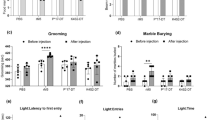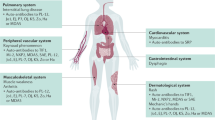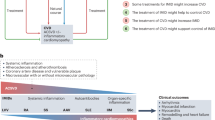Abstract
Rheumatic fever is one of the most-neglected ailments, and its pathogenesis remains poorly understood. The major thrust of research has been directed towards cross-reactivity between streptococcal M protein and myocardial α-helical coiled-coil proteins. M protein has also been the focus of vaccine development. The characteristic pathological findings suggest that the primary site of rheumatic-fever-related damage is subendothelial and perivascular connective tissue matrix and overlying endothelium. Over the past 5 years, a streptococcal M protein N-terminus domain has been shown to bind to the CB3 region in collagen type IV. This binding seems to initiate an antibody response to the collagen and result in ground substance inflammation. These antibodies do not cross-react with M proteins, and we believe that no failure of immune system and, possibly, no molecular mimicry occur in rheumatic fever. This alternative hypothesis shares similarity with collagen involvement in both Goodpasture syndrome and Alport syndrome.
This is a preview of subscription content, access via your institution
Access options
Subscribe to this journal
Receive 12 print issues and online access
$189.00 per year
only $15.75 per issue
Buy this article
- Purchase on SpringerLink
- Instant access to full article PDF
Prices may be subject to local taxes which are calculated during checkout




Similar content being viewed by others
References
Reményi, B. et al. World Heart Federation criteria for echocardiographic diagnosis of rheumatic heart disease—an evidence-based guideline. Nat. Rev. Cardiol. 9, 297–309 (2012).
World Health Organisation. Rheumatic fever and rheumatic heart disease. Report of a WHO expert consultation. WHO [online], (2004).
Marijon, E. et al. Prevalence of rheumatic heart disease detected by echocardiographic screening. N. Engl. J. Med. 357, 470–476 (2007).
Carapetis, J. R. et al. Evaluation of a screening protocol using auscultation and portable echocardiography to detect asymptomatic rheumatic heart disease in Tongan schoolchildren. Nat. Clin. Pract. Cardiovasc. Med. 5, 411–417 (2008).
Stollerman, G. H. Rheumatogenic and nephritogenic streptococci. Circulation 43, 915–921 (1971).
Virmani, R., Farb, A., Burke, A. P. & Narula, J. in Rheumatic Fever (eds Narula, J., Virmani, R., Reddy, K. S. & Tandon, R.) 217–234 (Amer. Reg. Path. AFIP, Washington DC, 1999).
Veasy, L. G. et al. Resurgence of acute rheumatic fever in the intermountain area of the United States. N. Engl. J. Med. 316, 421–427 (1987).
Aschoff, L. The rheumatic nodules in the heart. Ann. Rheum. Dis. 1, 161–166 (1939).
Saphir, O. The Aschoff nodule. Am. J. Clin. Pathol. 31, 534–539 (1959).
Fischetti, V. A., Vashishta, A. & Pancholi, V. in Rheumatic Fever (eds Narula, J., Virmani, R., Reddy, K. S. & Tandon, R.) 113–134 (Amer. Reg. Path. AFIP, Washington DC, 1999).
Goldstein, I., Rebeyrotte, P., Parlebas, J. & Halpern, B. Isolation from heart valves of glycopeptides which share immunological properties with Streptococcus haemolyticus group A polysaccharides. Nature 219, 866–868 (1968).
Dudding, B. A. & Ayoub, E. M. Persistence of streptococcal group A antibody in patients with rheumatic valvular disease. J. Exp. Med. 128, 1081–1098 (1968).
Ayoub, E. M., Taranta, A. & Bartley, T. D. Effect of valvular surgery on antibody to the group A streptococcal carbohydrate. Circulation 50, 144–150 (1974).
Galvin, J. E., Hemric, M. E., Ward, K. & Cunningham, M. W. Cytotoxic mAb from rheumatic carditis recognizes heart valves and laminin. J. Clin. Invest. 106, 217–224 (2000).
Ellis, N. M. et al. Priming the immune system for heart disease: a perspective on group A streptococci. J. Infect. Dis. 202, 1059–1067 (2010).
Gorton, D. E. et al. Cardiac myosin epitopes for monitoring progression of rheumatic fever. Pediatr. Infect. Dis. J. 30, 1015–1016 (2011).
Kirvan, C. A., Swedo, S. E., Heuser, J. S. & Cunningham, M. W. Mimicry and autoantibody-mediated neuronal cell signaling in Sydenham chorea. Nat. Med. 9, 914–920 (2003).
Ellis, N. M. et al. T cell mimicry and epitope specificity of cross-reactive T cell clones from rheumatic heart disease. J. Immunol. 175, 5448–5456 (2005).
Faé, K. C. et al. Mimicry in recognition of cardiac myosin peptides by heart-intralesional T cell clones from rheumatic heart disease. J. Immunol. 176, 5662–5670 (2006).
Roberts, S. et al. Pathogenic mechanisms in rheumatic carditis: focus on valvular endothelium. J. Infect. Dis. 183, 507–511 (2001).
Gulizia, J. M. & McManus, B. M. in Rheumatic Fever (eds Narula, J., Virmani, R., Reddy, K. S. & Tandon, R.) 235–244 (Amer. Reg. Path. AFIP, Washington DC, 1999).
Narula, J. et al. Does endomyocardial biopsy aid in the diagnosis of active rheumatic carditis? Circulation 88, 2198–2205 (1993).
Roberts, W. C. & Virmani, R. Aschoff bodies at necropsy in valvular heart disease. Evidence from an analysis of 543 patients over 14 years of age that rheumatic heart disease, at least anatomically, is a disease of mitral valve. Circulation 57, 803–807 (1978).
Friedberg, C. K. Diseases of the Heart 4th edn 1322 (W. B. Saunders, Philadelphia, 1974).
Aretz, H. T. et al. Myocarditis: a histopathologic definition and classification. Am. J. Cardiovasc. Pathol. 1, 3–14 (1987).
Narula, J., Narula, N., Southern, J. F. & Chopra, P. in Rheumatic Fever (eds Narula, J., Virmani, R., Reddy, K. S. & Tandon, R.) 319–328 (Amer. Reg. Path. AFIP, Washington DC, 1999).
Gupta, M., Lent, R. W., Kaplan, E. L. & Zabriskie, J. B. Serum cardiac troponin-I in acute rheumatic fever. Am. J. Cardiol. 89, 779–782 (2001).
Vasan, R. S. et al. Echocardiographic, evaluation of patients with acute rheumatic fever and rheumatic carditis. Circulation 94, 73–82 (1996).
Kinsley, R. H., Girdwood, R. W. & Milner, S. in Surgery Annual Vol. 13 (ed. Nyhus, L. M.) 299–323 (Appleton-Century-Crofts, New York, 1981).
Hudson, B. G., Tryggvason, K., Sundaramoorthy, M. & Neilson, E. G. Alport's syndrome, Goodpasture's syndrome and type IV collagen. N. Engl. J. Med. 348, 2543–2556 (2003).
Pedchenko, V. et al. Molecular architecture of the Goodpasture autoantigen in anti-GBM nephritis. N. Engl. J. Med. 363, 343–354 (2010).
Dinkla, K. et al. Rheumatic fever-associated Streptococcus pyogenes isolates aggregate collagen. J. Clin. Invest. 111, 1905–1912 (2003).
Dinkla, K. et al. Identification of a streptococcal octapeptide motif involved in acute rheumatic fever. J. Biol. Chem. 282, 18686–18693 (2007).
Dinkla, K. et al. Crucial role of the CB3-region of collagen IV in PARF-induced acute rheumatic fever. PLoS ONE 4, e4666 (2009).
Nitsche, D. P., Johansson, H. M., Frick, I. M. & Mörgelin, M. Streptococcal protein FOG, a novel matrix adhesin interacting with collagen I in vivo. J. Biol. Chem. 281, 1670–1679 (2006).
Barroso, V. et al. (2009). Identification of active variants of PARF in human pathogenic group C and group G streptococci leads to an amended description of its consensus motif. Int. J. Med. Microbiol. 299, 547–553 (2009).
Aoudjit, F. & Vuori, K. Matrix attachment regulates Fas-induced apoptosis in endothelial cells: a role for c-flip and implications for anoikis. J. Cell Biol. 152, 633–643 (2001).
Arid, W. C. Endothelial cell heterogeneity. Crit. Care Med. 31, S228–S230 (2003).
Butcher, J. T., Simmons, C. A. & Warnock, J. N. Mechanobiology of the aortic heart valve. J. Heart Valve Dis. 17, 62–73 (2008).
Liu, A. C. & Gottlieb, A. I. in Molecular Pathology: The Molecular Basis of Human Disease Part IV, Chapter 14 (eds Coleman, W. & Tsongalis, G. J.) 228 (Academic Press, Madrid, 2009).
Janzer, R. C. & Raff, M. C. Astrocytes induce blood-brain barrier properties in endothelial cells. Nature 325, 253–257 (1987).
Affara, M. et al. Understanding endothelial cell apoptosis: what can the transcriptome, glycome and proteome reveal? Philos. Trans. R. Soc. Lond. B Biol. Sci. 362, 1469–1487 (2007).
Author information
Authors and Affiliations
Contributions
R. Tandon, Y. Chandrashekhar, M. H. Yacoub and J. Narula researched data for the article, substantially contributed to discussion of content, wrote the manuscript, and reviewed/edited the manuscript. M. Sharma researched data for the article, substantially contributed to discussion of content, and wrote the manuscript. M. Kotb researched data for the article, substantially contributed to discussion of content, and reviewed/edited the manuscript.
Corresponding author
Rights and permissions
About this article
Cite this article
Tandon, R., Sharma, M., Chandrashekhar, Y. et al. Revisiting the pathogenesis of rheumatic fever and carditis. Nat Rev Cardiol 10, 171–177 (2013). https://doi.org/10.1038/nrcardio.2012.197
Published:
Issue date:
DOI: https://doi.org/10.1038/nrcardio.2012.197
This article is cited by
-
Exploring the presence of oral bacteria in non-oral sites of patients with cardiovascular diseases using whole metagenomic data
Scientific Reports (2024)
-
Application of Transthoracic Echocardiography for Cardiac Safety Evaluation in the Clinical Development Process of Vaccines Against Streptococcus pyogenes
Drugs in R&D (2024)
-
New insight into the role of lipid metabolism-related proteins in rheumatic heart valve disease
Lipids in Health and Disease (2022)
-
Comparative analysis of the gut microbiota composition between knee osteoarthritis and Kashin-Beck disease in Northwest China
Arthritis Research & Therapy (2022)
-
Paediatric mitral valve disease - from presentation to management
European Journal of Pediatrics (2022)



